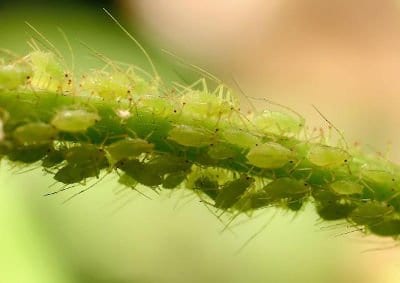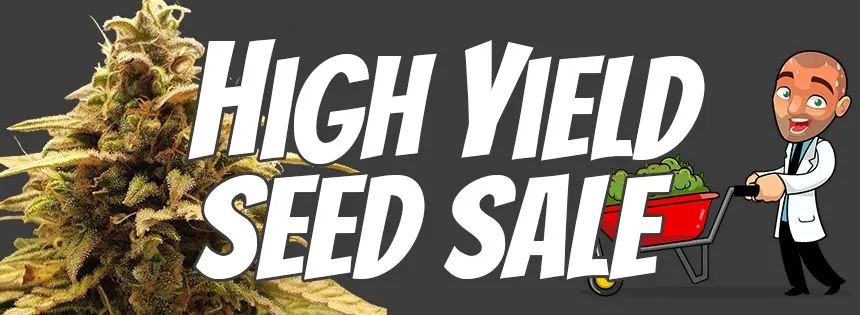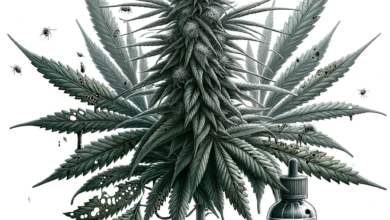Eliminate aphids on cannabis
Aphids are sap-sucking bugs that can be difficult to get rid of. This post will look at the different kinds of aphids, what causes them to attack cannabis plants, and how you can prevent them from infesting your crops.
If you’re a cannabis grower, then you know that aphids can be a real pain and can quickly infest your plants and ruin your crop. But don’t worry; there are some things you can do to prevent and eliminate aphids on cannabis.
First, it’s essential to keep your growing area clean. Aphids can quickly spread from plant to plant, so keeping your grow space clean is crucial. Be sure to remove any dead leaves or other debris that could harbor aphids.
What exactly is an aphid?
Aphids are small, pear-shaped insects that can be found in various colors, including green, yellow, brown, and black. These pests suck the sap out of plants, which can cause stunted growth, deformed leaves, and even death. Aphids also produce a sticky substance called honeydew, which can attract other pests and promote the development of sooty mold.
Belonging to the Hemiptera group of insects, aphids are parasites that reach approximately the size of a pinhead, or 1-3 mm. They are easy to spot with the naked eye and can appear in various colors, but most aphids are black, brown, or green. Usually, the difference depends on their food source.

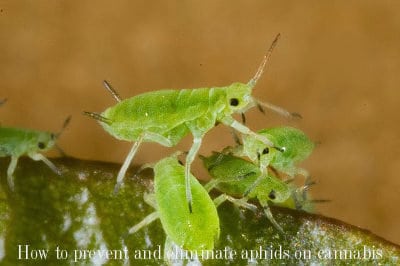 A widespread and destructive insect called an aphid is among the many insects, fungi, and viruses that can attack our marijuana plants. Aphids are a pest that can, in large colonies, destroy marijuana plants.
A widespread and destructive insect called an aphid is among the many insects, fungi, and viruses that can attack our marijuana plants. Aphids are a pest that can, in large colonies, destroy marijuana plants.
Having a plague of aphids is not the end; we have the necessary means to stop and eradicate the pest at our disposal. Although, as we always say, prevention is the best way to avoid these problems.
We will explain what an aphid is and how to prevent and eliminate them with home remedies and products made for this purpose.
What are aphids?
They have wings and can quickly spread from plant to plant when needed, although they typically congregate in colonies on the underside of leaves and stay there until the plant no longer provides any benefit to them. They will destroy one plant before going to another and repeating the process.
A unique feature of aphids is the secretion of a sugary substance called “honeydew.” This sticky material attracts ants and, in some cases, bees. Aphids develop a symbiotic relationship with both insects and use them as protection against predators such as ladybugs or wasps. There are situations in which the ants bring the aphids to a specific place to be able to collect their precious “honeydew.” They not only hurt the plants by extracting their sap but also transmit viruses and disease and facilitate the transmission of fungi.
As if this were not enough, when communities are extensive, aphids repeatedly pierce the stems of plants, seeking refuge there, laying eggs, etc. They breed more quickly in hot weather, so indoor crops are more likely to develop large communities of aphids.
Aphids pose a dangerous threat to cannabis plants, especially those grown in grow boxes or greenhouses. Warmer temperatures make these areas a breeding refuge for female aphids. The problem is further compounded by the fact that their reproduction cycle is relatively short, meaning they can multiply at an alarming rate under optimal conditions.
Conversely, in cold climates, they appear to disappear, something that can make us believe that we no longer have a problem, but unfortunately, nothing could be further from the truth. Their eggs can overwinter and hatch during months when temperatures rise again, starting to recolonize the plant.
They have a particular preference for the young shoots (new leaves and branches), although we can find them anywhere on the plant.
How to detect and prevent aphids on marijuana plants
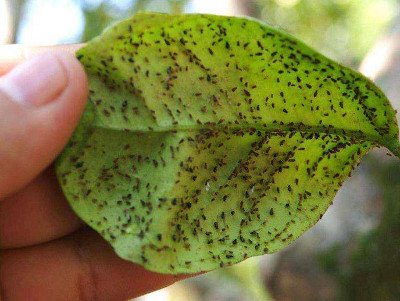 Identifying them is simple: they tend to congregate at the bottom of the leaves and around the young stems. It is one of the few pests that affect cannabis and can attack the branches. The honeydew we referred to earlier is a telltale sign. Not only does honeydew attract other pests, but it encourages mold growth. Look for black spots on the upper sides of the leaves.
Identifying them is simple: they tend to congregate at the bottom of the leaves and around the young stems. It is one of the few pests that affect cannabis and can attack the branches. The honeydew we referred to earlier is a telltale sign. Not only does honeydew attract other pests, but it encourages mold growth. Look for black spots on the upper sides of the leaves.
Luckily for us, they are straightforward to detect with a simple visual inspection of our plant. By observing stems and leaves (especially on the underside-bottom of the leaf), we can catch them immediately. They live in ever-expanding colonies, so we see a large infestation of white, yellow, or brown insects on close inspection. This will give us a final clue to determining whether we have an aphid infestation.
When the number of these insects is high, we will see how the leaves are dried, and new branches wither.. a sign that they are absorbing a lot of the lifeblood of our plant, which is the sap.
Preventative Measures
Aphids or any other insect infestation always have two golden rules for dealing with them. First, a clean and well-maintained growing environment is the best defense against pests, and this means removing weeds and cleaning tools and substrate between crops. Second, quick response to any pest threat will ensure that the damage is minimized. Immediate action is the best remedy for an infestation, so don’t wait!
Regular observation is the first preventative measure you can take. Checking your plants every week will make it much easier to spot aphids. Beware of warm, dry temperatures in early spring or if you use a lot of fertilizer. These are factors that can encourage the arrival of aphids.
Removing aphid pests on marijuana
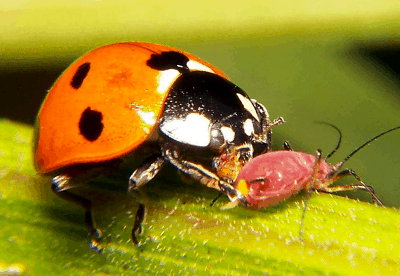 There are several ways to eliminate this annoying and destructive plague of our growing marijuana, which they recommend are clean alternatives (using natural products with 100% BIO), even if the pest is widespread. The flowering period has not yet begun. We can also use chemicals.
There are several ways to eliminate this annoying and destructive plague of our growing marijuana, which they recommend are clean alternatives (using natural products with 100% BIO), even if the pest is widespread. The flowering period has not yet begun. We can also use chemicals.
The best way to prevent this plague in our cannabis plants is to use a natural, 100% biological pest control method that does not adversely affect the plant or the environment. Ladybirds and their larvae are veracious hunters of aphids and should be encouraged in our gardens.
Aphids have many natural predators if you want to use mother nature to your advantage. Ladybugs are very effective in dealing with an aphid infestation, as are parasitic wasps.
The outbreak is dealt with naturally by releasing these predators when the early stages of an aphid problem are noticed. But if it’s not easy for you to have large numbers of insects or the infestation has already moved to a worrying level, organic pesticides are the next step.
Homemade sprays
Failing the natural predator route, we can use neem oil as a natural preventive, diluting it in water and spraying our plant every day in the veg cycle until the pest has been eliminated.
Finely chop some tomato leaves to fill two cups. Combine them with two cups of water in a large pitcher to hold both and let them sit overnight.
Strain the liquid, remove the leaves, and dilute with two more cups of water. The mixture can be used in a spray bottle to deal with aphids.
Snuff diluted with water and sprayed on plants is another homemade remedy. Nicotine is a potent poison used in many chemical insecticides, but it is advised that this preparation leaves a particularly unpleasant smell on our plants.
How to get rid of aphids naturally?
Aphids are small, soft-bodied insects that can be a big problem for cannabis growers. They suck the sap out of plants, weakening and even killing them. They also spread diseases, so getting rid of them as soon as possible is important.
Fortunately, there are several ways to get rid of aphids naturally. Here are a few of the most effective:
1. Use a strong stream of water to blast aphids off your plants. This will remove most of them, and the remaining ones will be much easier to deal with.
2. Mix water and soap and spray it on your plants. This will kill aphids on contact.
3. Mix water, garlic, and chili peppers and spray them on your plants. This will repel aphids and other pests.
4.Plant marigolds around your cannabis plants. These flowers produce a chemical that deters aphids and other pests.
5. Use beneficial insects like ladybugs and lacewings to eat aphids. 6. These predators are available from many garden centers and online retailers.
Apply neem oil to your plants. This natural
Neem oil and insecticidal soap
Neem oil and insecticidal soap are both excellent choices for treating aphids, and they shouldn’t affect your crops unless you spray them directly on developing flowers. They are available at garden stores, but if you prefer a homemade remedy for aphids, the following spray is easy to make.
Spray the spray on infested areas, including leaf stems and plant stems. Make sure you avoid flowers, as you don’t want your final product to taste like the spray. Some sprays can also burn young flowers. For this, spraying only the leaf’s surface as accurately as possible is essential.
Within natural alternatives, it is advisable to perform periodic treatments with neem oil and potassium soap diluted in water. With the help of a sponge and careful wiping of the leaves, it will remove aphids, taking care not to damage the plant. We repeat this every ten days until the infestation completely disappears.
We may also use pyrethrins (chrysanthemum extract), an organic product that acts as a natural insecticide and repellent. Some people use homemade preparations such as nettle slurry, which also acts as a natural insecticide.
Another remedy that others have had great success with is to dilute a few drops of dishwashing soap in a liter of water and spray the solution onto the insects; this has the effect of drying the insects out.
Whatever method you choose, follow the instructions carefully and apply the treatment evenly to all affected areas. With a little effort, you can get rid of those pesky aphids.
